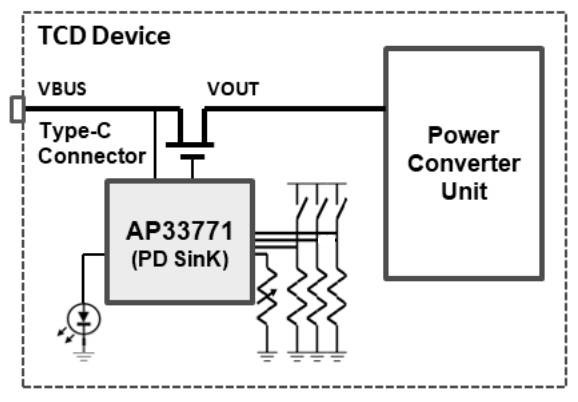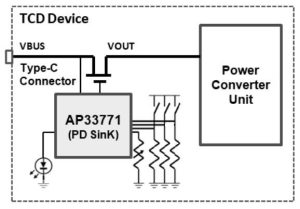
Both devices have built-in application firmware that automatically carries out USB PD 3.0 (v1.2) negotiation with a compliant charger to obtain the required power levels once connected.
- AP33771 is easier to use, with a pre-loaded power menu of eight pin-selected output voltage options (5 – 17.2V) and ten output power options (12 – 100W) selected by an external resistor. This is backward-compatible with Type-A connectors and includes automatic cable voltage loss compensation
- AP33772 is more flexible, and expects to be controlled by a host microcontroller though its I2C bus. It supports USB PPS in 20mV and 50mA steps
Both include a driver for a pair of back-to-back n-mos Vbus power switches. Max operating voltage is 24V, operating current is 3.3mA, and the devices can sleep at 550μA.
 As a user-interface, the simplified AP33771 can control an LED to indicate: charging, charged, fault or ‘mismatch’ by its flashing pattern. The latter indicating that it has been connected to a non-PD power source.
As a user-interface, the simplified AP33771 can control an LED to indicate: charging, charged, fault or ‘mismatch’ by its flashing pattern. The latter indicating that it has been connected to a non-PD power source.
For protection, both devices send a hard reset to the PD source if the input voltage rises too high, and enable an internal discharge path with the aim of reducing over-voltage duration.
On top of this, the more flexible AP33772 has a pin for an external 10kΩ thermistor that can be located at a suitable place within the enclosure, and has a register from which to read the temperature – temperature vs resistance values at 25, 50, 75 and 100ºC have to be set on internal registers for the scheme to work. A thermal power de-rating register is available to be used in conjunction with temperature sensing.
Product pages:
—







